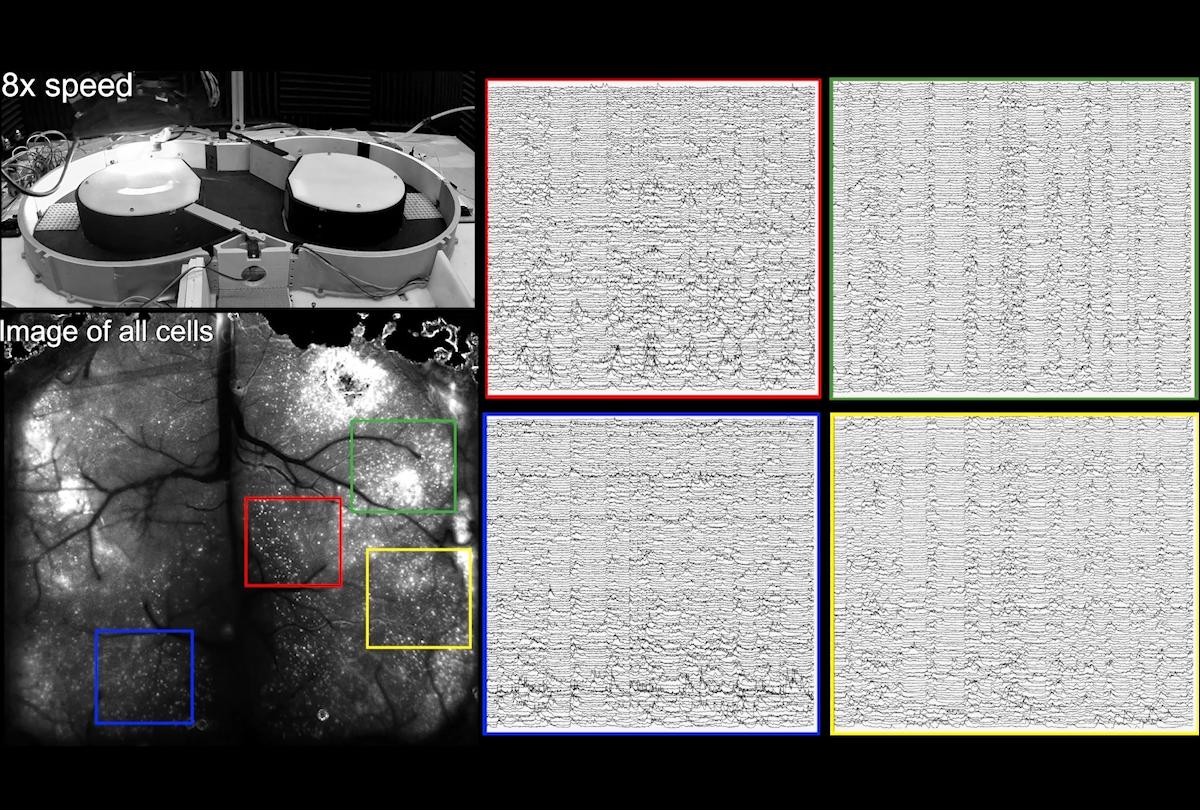A new head-mounted robot enables mice to move freely, despite being attached to heavy brain-recording machinery, according to a new preprint. The tool could help scientists dissect the neural circuits that control natural behaviors.
To measure brain activity in an awake mouse, scientists typically must fix the animal’s head in position beneath a microscope, limiting the types of behavior they can investigate. Adding a virtual environment and a treadmill can expand the behavioral possibilities by creating the illusion of movement through space but cannot fully replicate reality, says Ted Abel, chair of neuroscience and pharmacology at the University of Iowa in Iowa City, who was not involved in the study. “The vestibular system and interoception are important for navigation, and these sensations don’t show up if the head is fixed.”
Miniaturized microscopes fitted to a mouse’s head can minimize disruptions to the animal’s natural movement, but these devices have limited functionality and can only measure small brain regions at a time.
The new tool — a “cranial exoskeleton” — comprises a three-armed robot that senses the animal’s movement and moves with it. By connecting the robot to recording devices, researchers can investigate brain activity in detail as a mouse nimbly navigates its surroundings.
“This strikes me as a real advance,” Abel says. It’s “getting closer to naturalistic behaviors, enabling us to understand how the brain responds to the environment and how animals learn to navigate the environment.”
In the new preprint, the researchers inserted a 3D-printed implant into a mouse’s brain and used it to connect the rodent to the cranial exoskeleton. The device is made up of a headstage — which detects forces from the mouse’s head and predicts the animal’s intended movement — and the robot, which can rotate and move along three axes.
The team programmed the robot to move at the same speed, and accelerate as quickly, as mice not attached to the device. They then tested the exoskeleton on four mice navigating an oval track, using force feedback to fine-tune the robot’s movements. Pressure from the mouse’s head is detected by a motor, which moves the robot in a given direction. But if the robot moves faster than the mouse intended, the mouse’s resistance prompts the device to slow down.
Compared with unrestricted mice, animals maneuvering the exoskeleton walked with a similar stride but took fewer steps per minute — possibly because of the exoskeleton’s upper speed limit or the mouse’s inability to move its head up and down, the researchers write in the preprint.
Mice were able to steer the exoskeleton around corners in a maze and performed a decision-making task as effectively as unrestricted animals, the team found.
Satisfied that the mice could pilot the robot, the researchers attached it to a custom-built microscope designed to image large swathes of the brain. They then genetically engineered the mouse’s neurons to fluoresce in response to the calcium signals they emit when they fire. To get a good view of the glowing neurons, they also inserted a glass window into the skull of each mouse.
As four mice navigated a maze, the researchers imaged the firing patterns of thousands of neurons across the cortex. Further analysis revealed that many of the cells tended to fire at certain locations — when the mouse turned left or walked over a strip of Lego, for example.
By swapping the microscope with electrodes and a head-mounted camera, the researchers recorded neuronal activity as the mouse performed specific movements. The scientists posted their findings on the preprint server bioRxiv in June. (The work was led by Suhasa Kodandaramaiah at the University of Minnesota in Minneapolis, who declined to comment for this article because the work is unpublished.)
“The technological approach here is spectacular,” says Angelique Paulk, instructor in neurology at Massachusetts General Hospital in Boston, who was not involved in the study.
By outfitting the exoskeleton with more powerful probes or improved calcium imaging, scientists could collect even more data in moving mice, Paulk says. But its full potential depends on whether the tool is made accessible to the neuroscience community, she adds.
Others are less convinced of its impact.
“It’s a magnificent feat of engineering, but is it worth the complexity?” says Tim Harris, senior fellow at the Howard Hughes Medical Institute’s Janelia Research Campus in Ashburn, Virginia, who was not involved in the study. Given that the mice aren’t behaving naturally — after all, they have a robot strapped to their head — it’s unclear whether the new tool is significantly better than head-fixed approaches, which are simpler to implement, he says.
Cite this article: https://doi.org/10.53053/OVHA6647
This content was originally published here.
